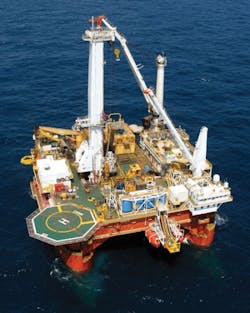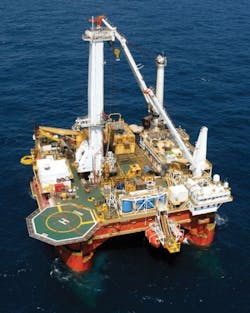BP PLC has outlined plans to collect 60,000-80,000 b/d of oil by mid-July from the deepwater Macondo blowout well on Mississippi Canyon Block 252 in the Gulf of Mexico. As OGJ went to press last week, federal officials were reviewing the plans.
By June 30, BP said it plans to be able to collect up to 40,000-53,000 b/d from the gulf. The collection capacity range represents installed design capacities of various drillships, tankers, and multiservice vessels that BP is currently using or plans to use.
A federal team of scientists and engineers updated the well flow rate on June 16, putting it at 35,000-60,000 b/d. The latest estimate is based on pressure measurements available after BP cut a riser pipe on June 3 and installed additional sensors (OGJ Online, June 11, 2010).
In establishing redundant containment systems, BP said a floating, production, storage, and offloading vessel from South America is being moved to the gulf. The 25,000 b/d-capacity FPSO will take 4 weeks to arrive.
Preparations are under way for a more-permanent and flexible containment system that will employ two floating risers. A second manifold was deployed on the seabed and a suction pile to anchor a riser also was installed. The floating riser systems are scheduled for operation by early July and will enable surface vessels to be disconnected and moved if a hurricane strikes the gulf.
BP is installing multiple collection systems pending the anticipated August completion of at least one of two relief wells currently being drilled.
Q4000 collecting oil
On June 16, BP announced oil and gas was flowing through a second spill containment system attached to the Transocean Ltd.'s Deepwater Horizon rig's failed blowout preventer (BOP). It's a direct connection with the Q4000 multiservice vessel.
BP's second collection system supplements a lower marine riser package (LMRP) cap system, which remains in operation. The Q4000 is expected to collect 5,000-10,000 b/d of oil. For a few weeks, the Q4000 will burn oil and gas using a clean-burning system until floating production units and tankers can be put into place.
The Q4000 system carries oil and gas through a manifold previously used in the failed "top kill" effort in May when BP tried to stop the flow from the runaway Macondo well in 5,000 ft of water (OGJ, June 7, 2010, p. 29).
Multiple strategies are being planned to expand leak containment capabilities. On June 14, BP collected 15,420 bbl of oil and flared 33.2 MMcf of gas through the LMRP cap system.
The Helix Producer, a 528-ft floating production unit with 45,000 b/d of capacity, is under contract to BP. Plans are for the Helix Producer to load oil onto the Toisa Pisces, a Liberian-flagged well testing and service vessel owned by Sealion Shipping Ltd. The Toisa Pisces can produce 20,000-25,000 b/d of oil.
The Helix Producer and Toisa Pisces are expected to be working on the spill site by June 30. In the future, BP also plans to use the Discoverer Leader, another Transocean deepwater drillship. It will be able to process 10,000-15,000 b/d of oil.
Spill estimate updated
US Sec. of Energy Steven Chu said the latest flow rate estimate brings together several scientific methodologies and the latest detailed information from the sea floor, which he called "a significant step forward in our effort to put a number on the oil that is escaping."
Flow Rate Technical Group teams continue collecting data and refining estimates, Chu said, adding, "It is important to realize that the numbers can change. In particular, the upper number is less certain—which is exactly why we have been planning for the worst-case scenario at every stage and why we are continuing to focus on responding to the upper end of the estimate."
Separately, the Unified Area Command said it will move its spill response staff from the 7-week base in Robert, La., to a 38,000-sq-ft space in New Orleans that will better facilitate continued 24-hr activities.
More Oil & Gas Journal Current Issue Articles
More Oil & Gas Journal Archives Issue Articles
View Oil and Gas Articles on PennEnergy.com



